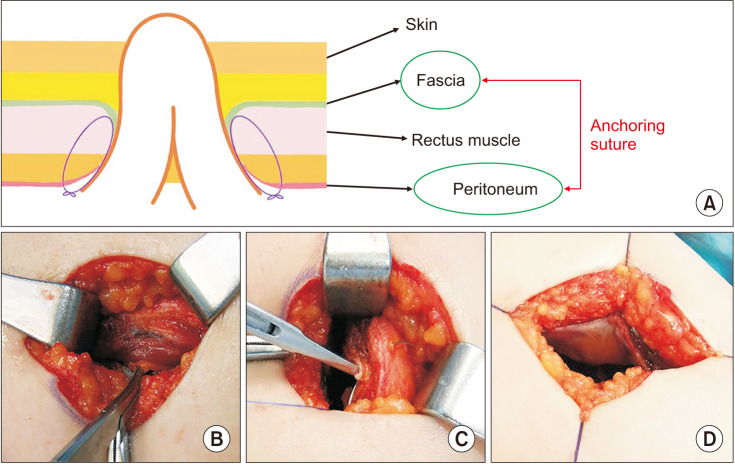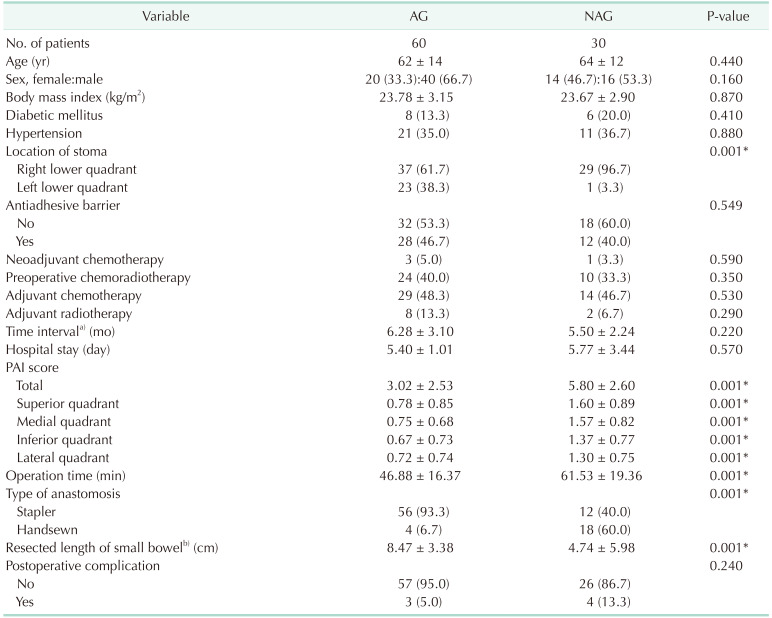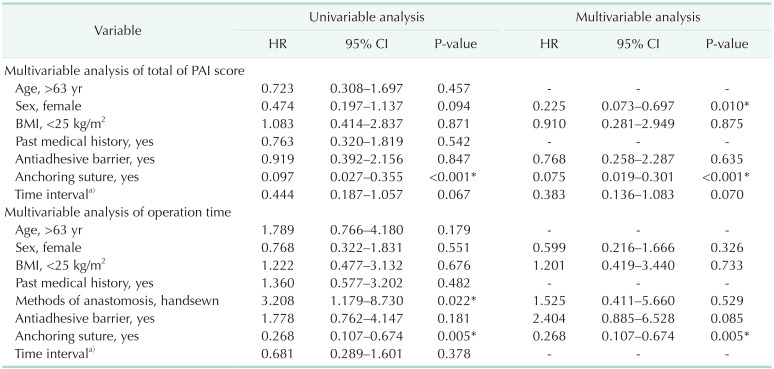1. Parker MC, Wilson MS, van Goor H, Moran BJ, Jeekel J, Duron JJ, et al. Adhesions and colorectal surgery: call for action. Colorectal Dis. 2007; 9 Suppl 2:66–72. PMID:
17824973.
2. Menzies D, Ellis H. Intestinal obstruction from adhesions: how big is the problem? Ann R Coll Surg Engl. 1990; 72:60–63. PMID:
2301905.
3. Cohen Z, Senagore AJ, Dayton MT, Koruda MJ, Beck DE, Wolff BG, et al. Prevention of postoperative abdominal adhesions by a novel, glycerol/sodium hyaluronate/carboxymethylcellulose-based bioresorbable membrane: a prospective, randomized, evaluator-blinded multicenter study. Dis Colon Rectum. 2005; 48:1130–1139. PMID:
15868230.

4. Kössi JA, Salminen PT, Laato MK. Surgical workload and cost of postoperative adhesion-related intestinal obstruction: importance of previous surgery. World J Surg. 2004; 28:666–670. PMID:
15185003.

5. Hanna MH, Vinci A, Pigazzi A. Diverting ileostomy in colorectal surgery: when is it necessary? Langenbecks Arch Surg. 2015; 400:145–152. PMID:
25633276.

6. Rullier E, Laurent C, Garrelon JL, Michel P, Saric J, Parneix M. Risk factors for anastomotic leakage after resection of rectal cancer. Br J Surg. 1998; 85:355–358. PMID:
9529492.

7. Bhama AR, Batool F, Collins SD, Ferraro J, Cleary RK. Risk factors for postoperative complications following diverting loop ileostomy takedown. J Gastrointest Surg. 2017; 21:2048–2055. PMID:
28971302.

8. Hendren S, Hammond K, Glasgow SC, Perry WB, Buie WD, Steele SR, et al. Clinical practice guidelines for ostomy surgery. Dis Colon Rectum. 2015; 58:375–387. PMID:
25751793.

9. Bakx R, Busch OR, van Geldere D, Bemelman WA, Slors JF, van Lanschot JJ. Feasibility of early closure of loop ileostomies: a pilot study. Dis Colon Rectum. 2003; 46:1680–1684. PMID:
14668595.
10. Man VC, Choi HK, Law WL, Foo DC. Morbidities after closure of ileostomy: analysis of risk factors. Int J Colorectal Dis. 2016; 31:51–57. PMID:
26245947.

11. Kaiser AM, Israelit S, Klaristenfeld D, Selvindoss P, Vukasin P, Ault G, et al. Morbidity of ostomy takedown. J Gastrointest Surg. 2008; 12:437–441. PMID:
18095033.

12. Joh YG, Lindsetmo RO, Stulberg J, Obias V, Champagne B, Delaney CP. Standardized postoperative pathway: accelerating recovery after ileostomy closure. Dis Colon Rectum. 2008; 51:1786–1789. PMID:
18575937.

13. Keller DS, Champagne BJ, Stein SL, Ermlich BO, Delaney CP. Pilot study evaluating the efficacy of AlloMEM™ for prevention of intraperitoneal adhesions and peritoneal regeneration after loop ileostomy. Surg Endosc. 2013; 27:3891–3896. PMID:
23670746.

14. Beck DE. The role of Seprafilm bioresorbable membrane in adhesion prevention. Eur J Surg Suppl. 1997; (577):49–55.
15. Tjandra J, Chan MK. A sprayable hydrogel adhesion barrier facilitates closure of defunctioning loop ileostomy: a randomized trial. Dis Colon Rectum. 2008; 51:956–960. PMID:
18219530.

16. Tang CL, Seow-Choen F, Fook-Chong S, Eu KW. Bioresorbable adhesion barrier facilitates early closure of the defunctioning ileostomy after rectal excision: a prospective, randomized trial. Dis Colon Rectum. 2003; 46:1200–1207. PMID:
12972964.
17. Coccolini F, Ansaloni L, Manfredi R, Campanati L, Poiasina E, Bertoli P, et al. Peritoneal adhesion index (PAI): proposal of a score for the “ignored iceberg” of medicine and surgery. World J Emerg Surg. 2013; 8:6. PMID:
23369320.

18. diZerega GS. The cause and prevention of postsurgical adhesions: a contemporary update. Prog Clin Biol Res. 1993; 381:1–18.
19. Rajfer J. Role of fibrin in the development of surgical adhesions. Rev Urol. 2005; 7:238–239. PMID:
16985838.
20. Siegbahn A, Ruusuvaara L. Age dependence of blood fibrinolytic components and the effects of low-dose oral contraceptives on coagulation and fibrinolysis in teenagers. Thromb Haemost. 1988; 60:361–364. PMID:
3149043.

21. Steptoe A, Kunz-Ebrecht S, Owen N, Feldman PJ, Rumley A, Lowe GD, et al. Influence of socioeconomic status and job control on plasma fibrinogen responses to acute mental stress. Psychosom Med. 2003; 65:137–144. PMID:
12554825.

22. Veldhuijzen van Zanten JJ, Ring C, Burns VE, Edwards KM, Drayson M, Carroll D. Mental stress-induced hemoconcentration: sex differences and mechanisms. Psychophysiology. 2004; 41:541–551. PMID:
15189477.

23. Leung TT, MacLean AR, Buie WD, Dixon E. Comparison of stapled versus handsewn loop ileostomy closure: a meta-analysis. J Gastrointest Surg. 2008; 12:939–944. PMID:
18071833.







 PDF
PDF Citation
Citation Print
Print




 XML Download
XML Download